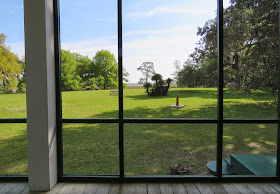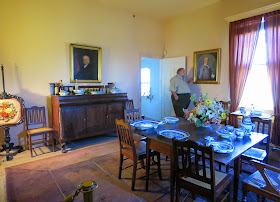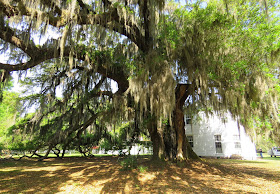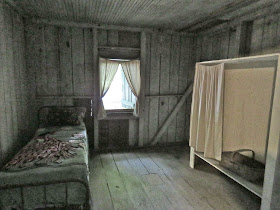Hofwyl-Broadfield Plantation, once a thriving rice plantation on the Atamaha River, provides a fascinating glimpse into the lives and culture of the Georgia rice coast from 1800 to 1915.
In 1806 William Brailsford, a Charleston merchant of English descent, purchased the undeveloped "Broadface" property from the son of Lachlan McIntosh who owned the adjacent General's Island Plantation. Broadface was an area of cypress swamp along the Altamaha River near Darien.
Brailsford brought experienced slaves from South Carolina to clear and drain the swamp for cultivating rice, and renamed it Broadfield Plantation.
Hundreds of slaves constructed miles of dikes and irrigation ditches.
Floodgates were built in the dikes to let water in to flood the rice fields during growing season.After Brailsford's death the land passed to his son-in-law, Dr. James Troup. By the time of Dr. Troup's death in 1849, the plantation included 7,300 acres and 357 slaves.
Some of the dikes remain,
as well as irrigation ditches.
The ruins of the rice mill can be seen.
But rice production ceased in 1913, and the fields have returned to marshland.
The name Hofwyl was added to the name when Ophelia Troup and her husband, George Dent, constructed the house that stands today. It was named for the school Dent attended in Switzerland. The plain-style house was built in the 1850s.
After the war, large tracts of land were sold to pay taxes. In the 1880s, Dent's son James took over management. Although James continued to grow rice until his death in 1913, without the cheap labor of slaves, it was no longer profitable, and the plantation was in debt. His son Gratz established a dairy which was operated until 1942 by his sisters Miriam and Ophelia Dent.
Our tour begins on the screened front porch.
The foyer…The last remaining descendent, Ophelia Dent, willed the property and all its contents to the State of Georgia, when she died in 1973.
The house is furnished just as it was when she died, with all the family furnishings…some antiques dating back to 1790s. The red chair by the desk in the back is where Ophelia died.
The dining room with family china.One of the family members painted this fire screen…I can't remember which one.
The fish dishes were for placing fish bones, and the warming plate was filled with hot water to keep food warm.
This platter had a built-in gravy boat.
A downstairs bedroom is where Ophelia slept in her last years. This is an early photo of her. She was under 5 feet tall.
The screens on the fireplaces helped to keep out mosquitos.
Ophelia knitted this bedspread….one square at a time.
Some of her clothing is still in her wardrobe. This is a Mamie Eisenhower-style hat.
Rugs were rolled up and stored in the attic during the summer months.
Generations of family photos are in all the rooms. Although electricity was added to the house, Ophelia preferred to use candles.
Stairs to the attic.
James Dent fought for the Confederacy. This is the oath he had to sign after the surrender not to take up arms again against the U.S.
In his bedroom is a rare antique…a Rice Bed.
The two foot posts are carved with "rice." The headboard and posts were undecorated because they were covered with curtains. Only a few of these circa 1790 beds exist.
Hook for hanging curtains or mosquito netting on the bed.One of the sister's bedroom.
The stairway.
Indoor bathrooms were added in 1949. The bedroom on the left has a piece of furniture with a bidet hidden in a drawer.
Another upstairs bedroom, perhaps used as a guestroom.
Screened back porch.
Looking out the back door.
The original kitchen is in an attached building. I'm sure a more modern kitchen was added inside, but it was not part of the tour.
There are two large live oaks flanking the house, named for the two sisters. Ophelia Oak is estimated to be about 800 years old.
It's branches have taken root on the left.
One of the slave/servant quarters remains.
They were duplexes, sharing a common wall with a double fireplace.
Humble furnishings.
These are the dairy buildings that were used until 1942. The milking barn is on the left and the bottling house is on the right. By the time they closed the dairy, the plantation was out of debt.
The brick wall encloses a laundry area, the building held a smokehouse, and later an icehouse and a garage.
Still inside the garage is the last car Ophelia bought, a 1970 Oldsmobile Cutlass Supreme.
Miriam Oak could be about 500 years old.
If trees could speak…what stories they could tell!

















































Wow!
ReplyDeleteLoved the "tour".
Thank you. :-)
Anne (from WomenRv)